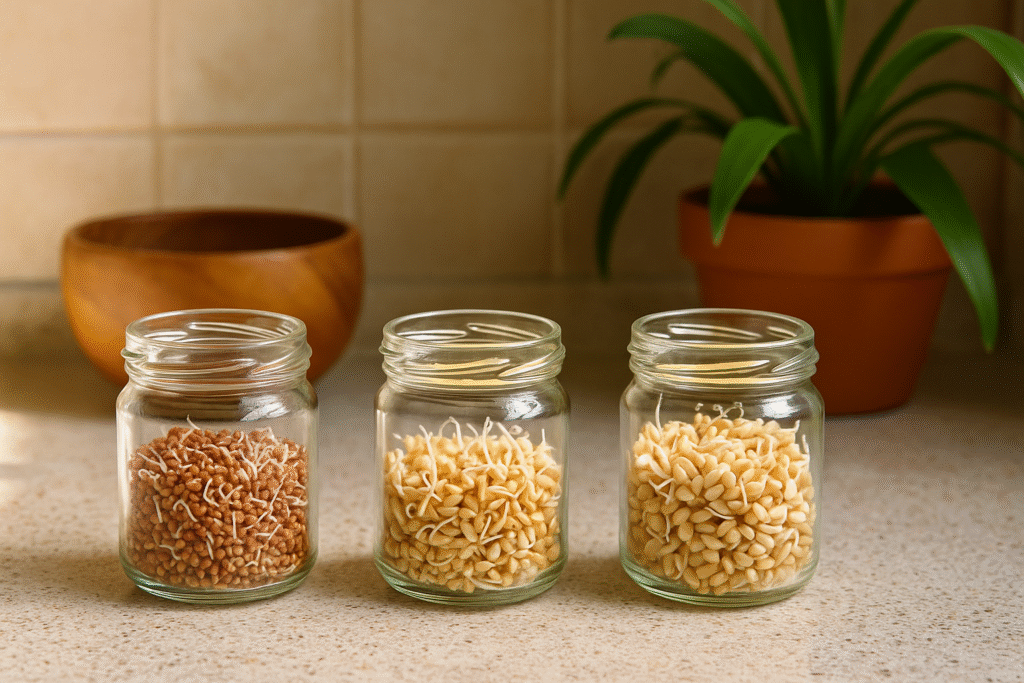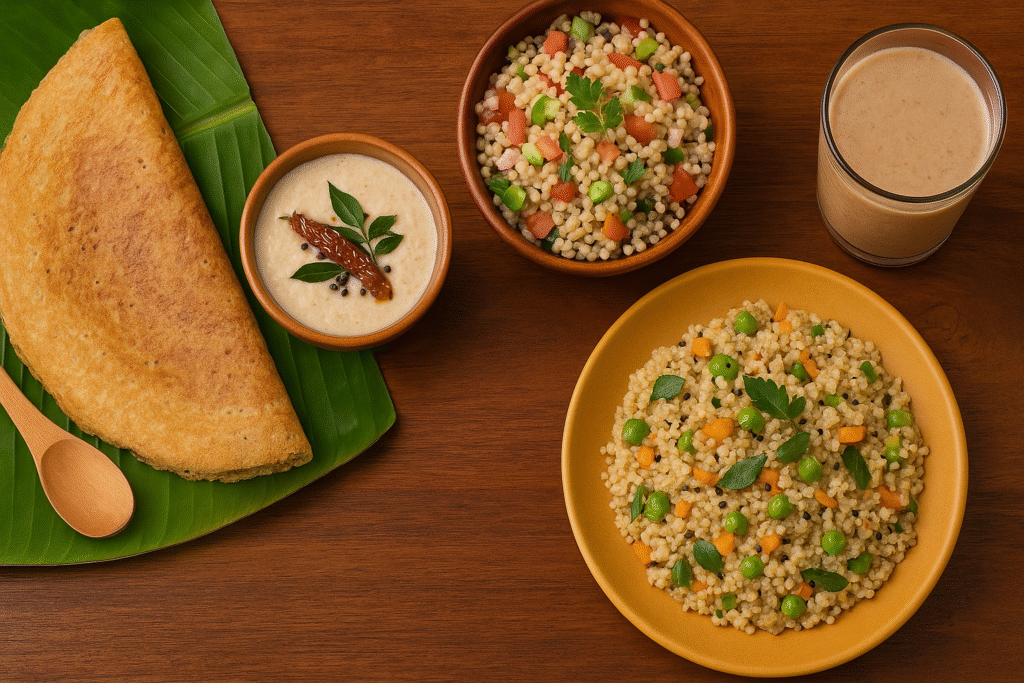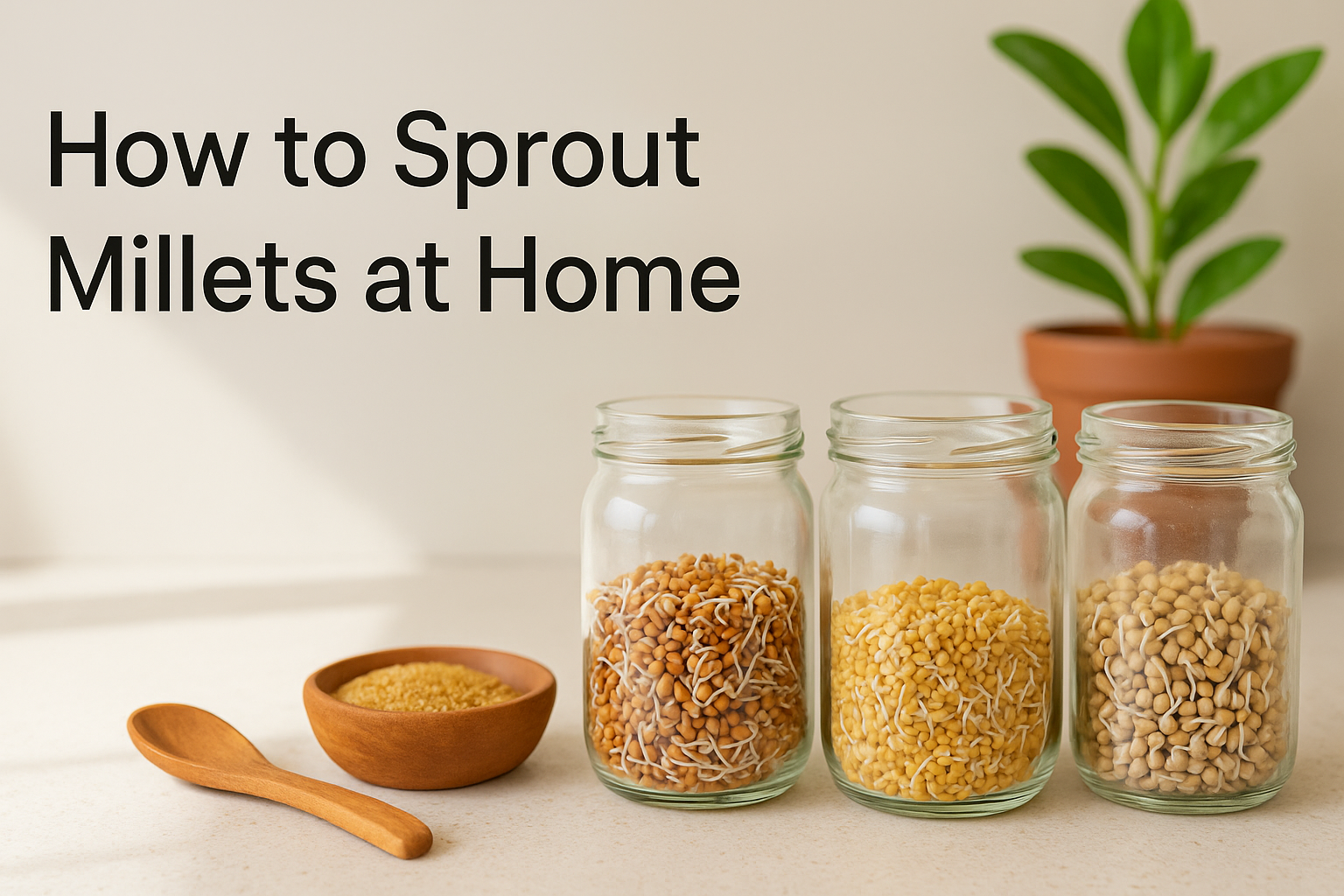Sprouting millets at home is a small kitchen habit that can bring a big shift in health. In India, millets like ragi, bajra, and foxtail millet are already loved for their earthy taste and strong nutrition value. When they’re sprouted, their nutrients get a boost — vitamins increase, digestion improves, and the texture becomes softer.
Many people don’t realise how easy it is to sprout millets at home with basic tools. It takes just a bowl, some clean water, and a bit of patience. This guide breaks it all down — how to do it right, avoid common slip-ups, and use sprouted millets in everyday Indian meals without losing their flavor.
The Science Behind Sprouting and Millet Germination in Simple Kitchen Terms
When you soak and rest millets, they start to “wake up” — enzymes become active, proteins break down, and new nutrients form. The germination process increases vitamins like B and C, while reducing anti-nutrients such as phytic acid that block iron and calcium absorption.
It’s nature’s way of improving what’s already healthy. Soaked and sprouted millets also digest faster, making them gentle on the stomach. For anyone with acidity or bloating, this process helps a lot.
Millets That Sprout Easily and Offer Maximum Nutrition in Indian Homes
Sprouting makes these grains fluff up beautifully. The change in texture helps them cook faster too — a bonus for Indian kitchens where every minute counts.
Step-by-Step Process to Sprout Millets at Home Easily Without Any Fancy Tools
Step 1: Clean and soak
Take one cup of millet and rinse it well to remove dust. Soak it in clean drinking water for 6 to 8 hours.
Step 2: Drain and rinse again
After soaking, drain all water and rinse once more. This keeps the grains fresh.
Step 3: Keep it covered and moist
Wrap the wet millets in a muslin cloth or place them in a jar. Cover lightly, not airtight. Keep it in a warm corner of your kitchen (around 25–30°C).
Step 4: Wait and watch
In about 18 to 36 hours, you’ll see small white roots popping. That’s when they’re ready to eat or cook.

Tip: If the weather’s too humid, rinse once every 10–12 hours to avoid any weird smell.
Mistakes That Stop Millets From Sprouting Properly at Home
- Soaking for too long leads to soggy grains
- Keeping them in direct sunlight can kill the seed
- Using chlorinated tap water slows germination
- Sealing the jar without airflow traps moisture and causes fungus
A small trick — keep the jar tilted with a cloth cover so air can move freely.
How Sprouted Millets Help Nutrition Absorption and Digestion
Sprouting improves protein quality, increases vitamin B and C, and helps the body absorb minerals like iron and calcium much better. The process also reduces starch, so the carbs become lighter.
Raw millets are high in antinutrients that block absorption, but once sprouted, these are gone. It’s the same reason why sprouted grains feel easier on the gut and keep you full for long hours.
| Nutrient | Before Sprouting | After Sprouting |
| Vitamin C | None | 15–25 mg |
| Protein Quality | Low | Improved |
| Fiber Digestibility | Average | High |
| Mineral Absorption | Low | Higher |
Indian Dishes and Everyday Ideas Using Sprouted Millets
You can use sprouted millets in so many local recipes:
- Sprouted millet dosa or idli batter – gives a soft, slightly nutty taste
- Millet salad with sprouts – mix with veggies, lemon, and salt
- Sprouted millet upma or khichdi – ideal for breakfast
- Ragi malt or smoothie – blend with banana or jaggery
It’s simple home food that works great for both energy and digestion.
Best Ways to Store and Keep Sprouted Millets Fresh for a Few Days
- Keep them in an airtight glass jar
- Store in fridge (max 3 days)
- For longer storage, dry them in shade and keep in freezer-safe pouches
- Avoid plastic containers – they trap moisture and change smell
Key Health Benefits of Sprouted Millets in an Indian Diet
- Helps in weight loss due to high fiber
- Keeps blood sugar stable, great for diabetic diets
- Boosts gut health and reduces constipation
- Improves immunity and strengthens bones due to better calcium absorption
- Great for kids, women, and fitness-focused adults
Sprouted millets are also known for giving sustained energy — unlike polished rice, they don’t cause sugar spikes.
Cost-Effective and Eco-Friendly Millet Sprouting for Indian Homes
Sprouting doesn’t need fancy gadgets or high cost. You can reuse kitchen jars and cotton cloths. It saves money and supports local millet farmers. Choosing Indian millets like ragi, bajra, and kodo also helps promote sustainable food habits in daily life.

Even in small urban kitchens, this fits perfectly — easy, clean, and nutrient-loaded.
Also Read: Bajra or Jowar: Whish is best for Weight Loss in India?
Conclusion – A Simple Habit That Keeps You Nourished and Grounded
Sprouting millets at home is no big deal, yet the benefits are so huge. A cup of soaked millets turns into a bowl full of nutrition that your body actually enjoys digesting. It’s light, balanced, and fits perfectly in Indian meals.
Next time you plan breakfast, skip the processed stuff and use sprouted millets instead. It’s a local, powerful, and mindful way of eating that supports both your body and the farmers who grow these amazing grains.

